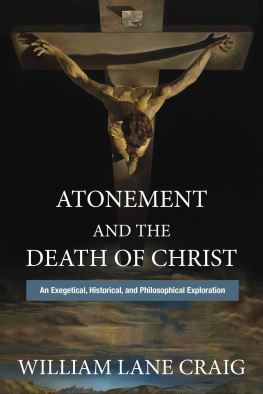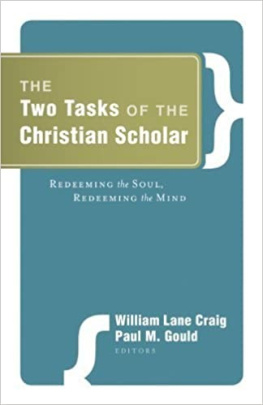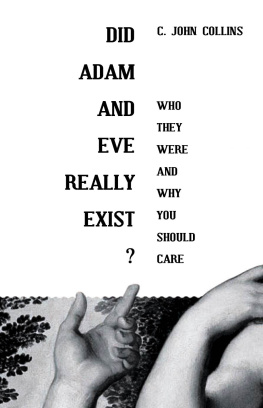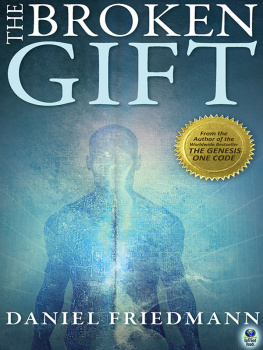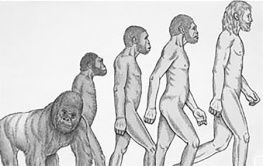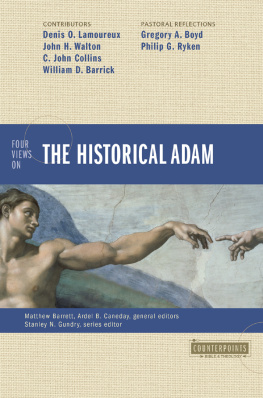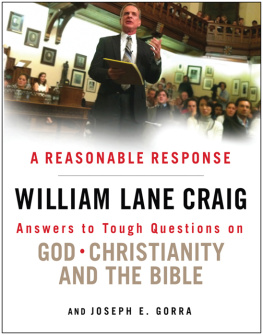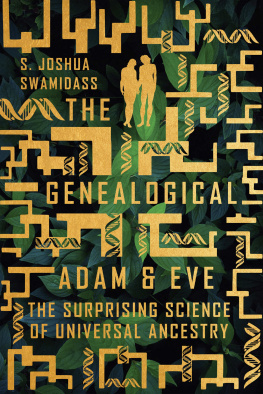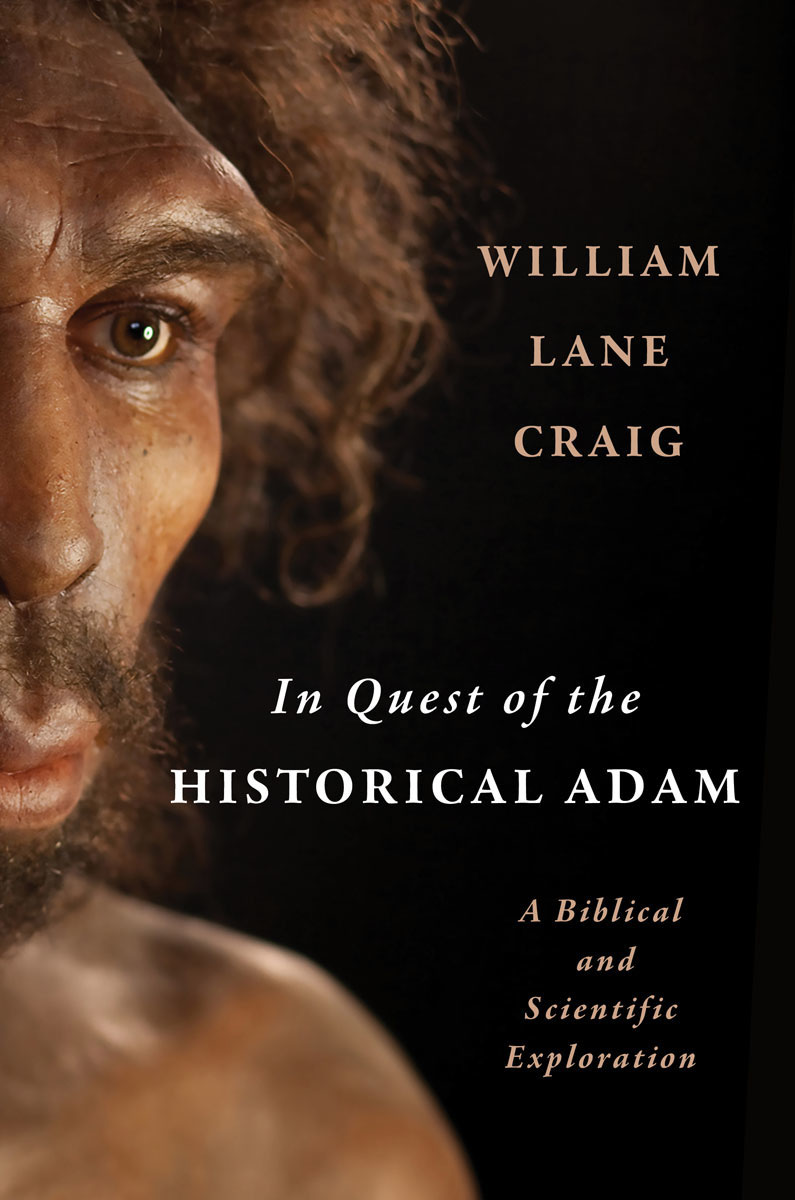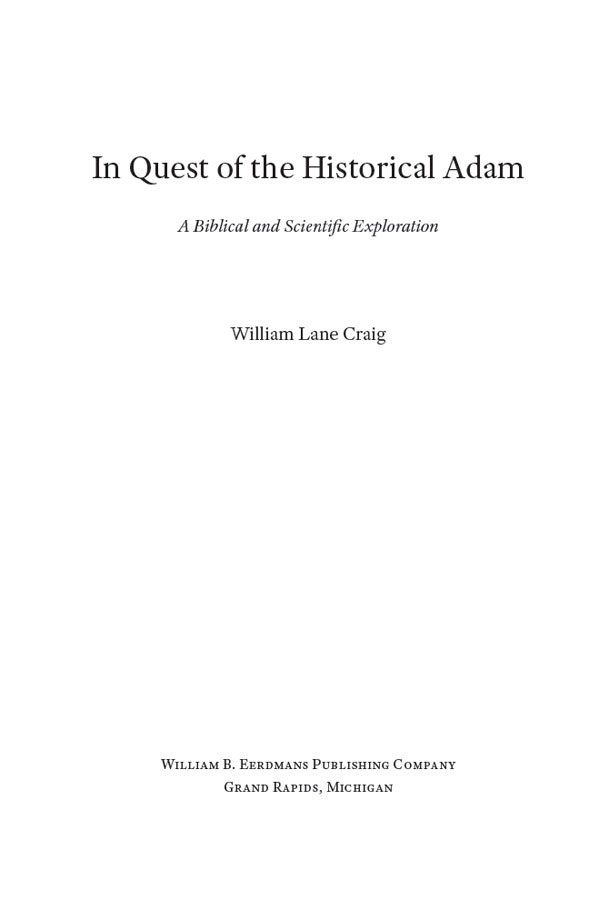This volume covers an amazing amount of territory in both biblical and scientific studies relevant to the question of the historical Adam and Eve. The authors wide reading, amazing erudition, and carefully articulated judgment shine through. One does not need to agree with every point the author makes, every step in his argument, or his conclusions to gain a great deal from reading this volume. He faces the issues squarely, explains them clearly, and carries the reader along with him well. Those who seek to contribute to this discussion going forward must pay careful attention to what this highly accomplished scholar has set forth so well in this book.
RICHARD E. AVERBECK
professor of Old Testament at Trinity Evangelical Divinity School
This book truly is a quest, an intellectual journey, beginning with Scripture and ending in a meaningful exchange with science. Craigs quest brings him into an ancient and growing conversation about human origins, a storied exchange between many theologians, philosophers, and scientists. In this conversation, many fear that it is only by compromising our core commitments that space is made for evolutionary science. This book demonstrates, to the contrary, an account of human origins that makes space for evolution without capitulating to a science-only view of the world. Craig shows us not only that constructive dialogue between theology and science is possible, but also that theological questions can sharpen our understanding of science. The scientific content in this book will be surprising to many, but it is sound, even as it gives a much-needed pushback on overreach by evolutionary creationists. We find that many scientists misunderstood, and even overstated, the scientific evidence against Adam and Eve, ancestors of us all. Craigs explanation of how genetic evidence does, and does not, delimit human origins is true to our current scientific understanding. In so clearly making this scientific corrective, this book promises to be a landmark, a gift to the church, with reverberating significance to the conversation. His telling of the science makes space for many ways of understanding everything together, so the conversation should not end here. May we together be drawn deeper into the mystery, enticed to explore with one another what science is discovering about when and how humanness arises in our past. Could sacred and natural history entwine, telling us something important about who we are and what it means to be human?
S. JOSHUA SWAMIDASS
associate professor of laboratory and genomic medicine at Washington University in St. Louis
This is a book for those who want to pursue the truth. Here William Lane Craig combines thorough research and judicious weighing of the arguments to show that the biblical picture of human origins, rightly understood, can match very well with the best results of the sciencesagain, rightly understood. He holds all of these disparate disciplines accountable to the requirements of sound reasoning. Craigs honesty and bracingly relentless logic make it a pleasure to follow his detailed discussions and allow us to feel the attraction of his proposed location of Adam and Eve. He challenges and equips us to engage these issues at his own high and responsible level, for which I thank him.
C. JOHN COLLINS
professor of Old Testament at Covenant Theological Seminary
There has been a great deal of recent scholarly debate and discussion concerning the historicity of Adam and Eve. However, few treatments of the subject are able to bring together biblical, theological, philosophical, and scientific perspectives simultaneously. In this volume, Dr. Craig does just thatweaving these threads together in ways that respect orthodox Christian doctrine and incorporate our best current understanding of the origins of our species. All Christian scholars wrestling with this topic will benefit from Craigs deep and learned treatment.
MICHAEL J. MURRAY
senior visiting scholar of philosophy at Franklin and Marshall College
Wm. B. Eerdmans Publishing Co.
4035 Park East Court SE, Grand Rapids, Michigan 49546
www.eerdmans.com
2021 William Lane Craig
All rights reserved
Published 2021
Printed in the United States of America
27 26 25 24 23 22 21 1 2 3 4 5 6 7
ISBN 978-0-8028-7911-0
Library of Congress Cataloging-in-Publication Data
Names: Craig, William Lane, author.
Title: In quest of the historical Adam : a biblical and scientific exploration / William Lane Craig.
Description: Grand Rapids, Michigan : William B. Eerdmans Publishing Company, 2021. | Includes bibliographical references and indexes. | Summary: An interdisciplinary investigation into the historicity of the biblical figure of Adam, drawing upon Old and New Testament studies and a wide range of scientific disciplinesProvided by publisher.
Identifiers: LCCN 2021013206 | ISBN 9780802879110 (hardcover)
Subjects: LCSH: Adam (Biblical figure) | Bible. Genesis, IXICriticism, interpretation, etc. | Theological anthropology. | Paleoanthropology.
Classification: LCC BS580.A4 C73 2021 | DDC 222/.11092 [B]dc23
LC record available at https://lccn.loc.gov/2021013206
Biblical quotations follow the Revised Standard Version unless otherwise noted.
To our grandson
Oliver,
whose quantal vowels would be
the envy of any Neanderthal
CONTENTS
FIGURES
PREFACE
Old Testament scholar Richard Averbeck has cautioned, No matter what you say (or write) about the early chapters of Genesis, you are in a lot of trouble with a lot of people. As I offer this book to the reading public, I am acutely conscious of Averbecks words. People on both the left and the right can be expected to be upset with this book and, unfortunately, its author. All I can do is plead that they give an honest and open-minded reading of the case I make for my conclusions. I assure my readers that this book is the result of a genuine struggle on my part with the evidence, both biblical and scientific, concerning the historical Adam.
This book is not a scholarly treatise, though it draws on high scholarship to make its case. Neither is it a superficial popularization, though I make an effort to explain technical terms to readers outside the many specialist disciplines featured in this book. My target audience is people like myself, persons who are Christian philosophers, theologians, and other academics but who are neither Old Testament scholars nor scientiststhough I hasten to add that Old Testament scholars will profit greatly from the discussion of the scientific evidence for human origins in this book, and specialists in the various scientific disciplines relevant to human origins will likewise profit greatly from the discussion of the biblical issues to be found in these pages. By thus simplifying the material for nonspecialists, I make the book useful as well to intelligent laymen who are not academics, for we are all laymen when it comes to areas outside our areas of specialization.
The reader will soon notice quite lengthy footnotes attending the main text. These provide a sort of running discussion of the text, where considerably more detail can be provided without interrupting the flow of the text. By this means I am able to streamline the main text, keeping it succinct and moving forward at a good pace. Readers who want more detail are advised to consult the accompanying notes.


